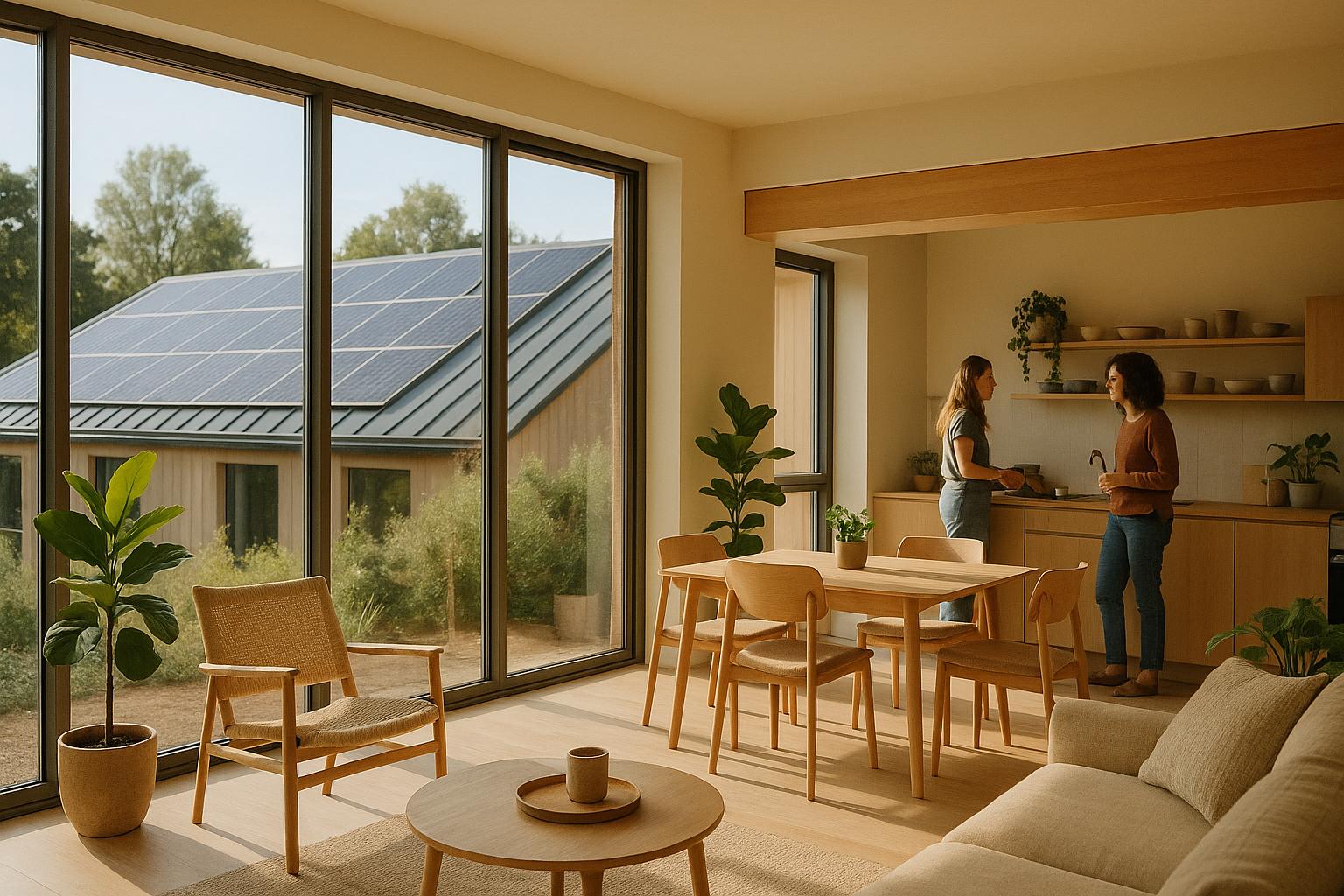Freelancers are increasingly turning to coliving as a smart housing option. Here's why:
- Lower Costs: Coliving spaces cost 20–50% less than renting traditional apartments. For example, in New York City, coliving averages $1,799/month compared to $3,500 for a studio.
- Flexibility: Month-to-month leases with just 30 days' notice make it easy to move for projects or explore new cities.
- Community: Shared spaces reduce isolation, with 71% of residents feeling less lonely and 58% forming close friendships.
- Convenience: Fully furnished spaces with utilities, Wi-Fi, and amenities included in one payment simplify moving and budgeting.
- Work-Life Balance: On-site coworking areas, meeting rooms, and wellness amenities support productivity and mental health.
Coliving aligns with the freelance lifestyle by offering affordability, social connections, and mobility - all in one package.
Main Benefits of Coliving for Freelancers
Coliving tackles both financial and social hurdles freelancers often face, offering a blend of cost efficiency, community, and improved work-life balance that supports both personal and professional growth.
Lower Costs and Simplified Budgeting
In cities like New York and Atlanta, coliving can slash housing expenses by nearly half compared to traditional apartments. For example, in New York City, coliving spaces average $1,799 per month, while studio apartments typically cost around $3,500. In Atlanta, coliving starts at about $719, whereas one-bedroom apartments average $1,714.
Beyond monthly rent, traditional renting comes with hefty upfront expenses. Security deposits often equal one to two months' rent, and furnishing an apartment can cost between $2,000 and $5,000 or more. Coliving eliminates these hurdles with minimal deposits and fully furnished spaces that are ready to move into.
Another advantage? Coliving offers an all-inclusive monthly fee covering utilities, internet, and other essentials. This streamlined approach not only simplifies budgeting but also saves residents 15% to 20% compared to renting a studio in the same area.
| Initial Expense Type | Traditional Renting | Coliving |
|---|---|---|
| Security Deposit | 1–2 months' rent | Minimal or none |
| Furnishing Costs | $2,000–$5,000+ | Included |
| Setup Fees | Utilities, internet deposits | None |
| Move-In Readiness | No (requires setup) | Yes (immediate) |
And the benefits don't stop at financial savings - coliving also opens doors to valuable professional connections.
Community and Networking Opportunities
Coliving spaces are intentionally designed to encourage interaction among residents, many of whom share similar professional paths and ambitions. These organic connections often lead to collaborations, client referrals, and the exchange of industry knowledge.
Daily interactions with like-minded individuals can help combat the isolation freelancers sometimes experience. Plus, many coliving spaces host events, workshops, and networking sessions tailored to their residents, offering even more chances to build meaningful relationships.
Enhanced Work-Life Balance and Productivity
Beyond cost savings and community, coliving spaces are structured to improve work-life balance. Features like coworking areas, meeting rooms, and quiet zones help freelancers maintain a clear divide between work and personal life - something that can be tricky when working from home.
"Remote work provides the opportunity for greater intrinsic motivation in work and the ability to better manage the competing demands of work and home, leading to less conflict, stress and anxiety." - NJIT HR
Research backs these benefits: 80% of remote workers report better work-life balance, and 74% experience less stress. Many coliving spaces also include wellness amenities like fitness centers, meditation rooms, and outdoor areas, offering residents natural breaks and opportunities for physical activity. These features not only boost mental health but also enhance overall productivity.
How Coliving Fits the Freelance Lifestyle
Freelancing comes with a lot of unpredictability - shifting schedules, fluctuating income, and the constant need for essential resources. Coliving steps in as a perfect match, offering flexible leases, bundled amenities, and a sense of community that complements the ever-changing freelance lifestyle. Let’s dive into how shared resources, creative networks, and adaptable housing options make coliving a natural fit for freelancers.
Shared Resources and Simplified Expenses
Freelancers often juggle hefty costs for essentials like internet, utilities, and coworking spaces. Coliving simplifies this by rolling these necessities into a single, predictable monthly payment. This setup reduces monthly expenses and eliminates the hassle of managing multiple bills. With utilities, high-speed Wi-Fi, and fully furnished spaces included, freelancers can skip the upfront costs of setting up a workspace.
On top of that, coliving spaces often feature shared amenities like coworking areas, professional-grade printers, and conference rooms. These resources, which might otherwise be out of reach, are readily available, helping freelancers maintain a professional edge without breaking the bank.
A Built-In Creative Community
Freelancing can sometimes feel isolating, which isn’t exactly ideal for creativity or growth. Coliving spaces address this by fostering vibrant, collaborative communities. These environments encourage idea-sharing, networking, and even collaboration on projects.
Take The Hive Collective in San Francisco, for example. Residents there not only work together on projects but also host skill-sharing workshops and pop-up art shows in their shared spaces. Similarly, Brooklyn’s Quarters provides an inspiring environment where freelancers - whether writers, designers, or developers - can exchange ideas and spark new projects. These curated communities go beyond networking; they create opportunities for learning and cross-disciplinary collaboration.
Flexibility That Matches Freelance Life
Traditional leases often lock you into long-term commitments, which can be a headache for freelancers whose work and income can change month to month. Coliving offers short-term leases and quick move-in options, making it much easier to align housing with project timelines and financial shifts.
Whether you need a private studio for heads-down work or a shared space to connect with others, coliving provides the flexibility to adjust your living situation as your needs evolve. And with the global coliving market expected to grow at a rate of 17% annually over the next decade, it’s clear this housing model is becoming a go-to choice for remote professionals looking for adaptable solutions.
Coliving Trends and Hubs in the United States
The growing popularity of coliving is reshaping how freelancers live and work, with new trends and regional hubs emerging across the country. The coliving market is on a steady rise, valued at $7.82 billion in 2024, with North America accounting for 17.9% of this figure. By 2030, the market is expected to reach $16.05 billion, reflecting its increasing appeal.
Top Coliving Cities
New York City stands out as a prime destination for freelancers. With its extensive networks and diverse community, the city offers coliving spaces that foster connection and collaboration.
Los Angeles leads the country with the largest freelance workforce - 431,614 strong. Coliving spaces here often cater to creative professionals in industries like entertainment, tech, and design, featuring amenities like studios and regular networking events.
San Francisco attracts high-earning freelancers, with an average income of $51,903 per year. Coliving spaces in the city focus on premium amenities and tech-friendly environments designed to enhance productivity.
Miami has become a hotspot for freelancers, thanks to its lack of self-employment tax and a thriving international vibe. Coliving spaces in Miami often provide outdoor workspaces and global-minded communities, making the most of the city’s year-round warm weather.
Las Vegas offers freelancers an appealing mix of financial perks, including no state income tax and an average freelance income of $50,056. Coliving spaces here are tailored to meet the specific needs of remote workers.
Nashville combines affordability with a vibrant artistic culture. With no self-employment tax and lower housing costs, its coliving spaces often feature music-friendly amenities and collaborative environments, reflecting the city’s creative roots.
These cities highlight how regional characteristics can shape coliving spaces to meet the unique needs of freelancers.
New Trends in Coliving
Coliving isn’t just limited to major urban hubs anymore. New trends are making their way into secondary cities and suburban areas, offering freelancers quieter and more affordable options.
Smart technology is becoming a game-changer in coliving spaces. Residents can now use integrated systems to book shared areas, control climate settings, and manage resources with ease.
Eco-friendly living is another growing focus. Many spaces now include energy-efficient appliances, shared electric vehicles, and community gardens, appealing to freelancers with an interest in sustainability.
The single occupancy segment is thriving, accounting for 48.23% of market revenue in 2024. This trend reflects a preference for private workspaces that still allow for community interaction, leading to innovative designs that balance privacy and collaboration.
Diverse demographics are also shaping the coliving landscape. Spaces are now catering to a broader range of residents, including students, older adults, interns, and employees on short-term assignments. This diversity enriches the sense of community and provides valuable networking opportunities.
Lastly, remote work amenities have become essential. Modern coliving spaces now offer high-speed internet (minimum 100 Mbps), ergonomic desk setups, private meeting rooms, reliable power backup, and strong cellular coverage - everything freelancers need to stay productive.
These trends and innovations illustrate how coliving continues to evolve, creating flexible and supportive environments for today’s freelancers.
Practical Tips for Freelancers Considering Coliving
Careful planning is key to making coliving a positive addition to your freelance lifestyle rather than a source of stress.
Budgeting for Coliving
Coliving expenses go beyond just rent - they often include utilities, Wi-Fi, cleaning services, and shared amenities. Experts suggest allocating about 30% of your take-home pay to rent, 10–15% to food, and 5–10% to utilities.
Since freelance income can be unpredictable, it's smart to build a financial cushion. Create a budget that accounts for both your most profitable months and the leaner ones. Remember, coliving can help you save in unexpected ways. For instance, many setups include furniture, utility setups, and even access to office essentials like printers and meeting rooms - expenses you’d otherwise have to cover.
If you’re considering coliving in different cities, cost-of-living calculators can be incredibly helpful for comparisons. Once you’ve nailed down your budget, carefully review contracts to ensure they accommodate the ups and downs of freelance income.
Understanding Contracts and Policies
Coliving agreements often differ from standard leases, so it’s important to dig into the details. Pay close attention to deposit requirements and look for payment options that align with your cash flow as a freelancer.
Cancellation policies are another big one. As a freelancer, you might need to relocate quickly for a project or personal reasons. Look for spaces with reasonable notice periods and minimal penalties for early termination.
Make sure you understand exactly what’s included in your monthly payment. Some coliving arrangements charge extra for things like guest visits, premium room locations, or extended use of shared spaces. Knowing these costs upfront can help you avoid unpleasant surprises.
House rules also matter, especially if your work requires flexibility. For example, if you frequently take late-night client calls due to time zone differences, ensure the community’s quiet hours won’t interfere with your schedule.
Don’t overlook liability and insurance clauses. Many coliving spaces limit their responsibility for theft or damage to personal belongings. Check whether your current insurance covers your equipment or if you need additional coverage.
Lastly, confirm that the coliving space complies with local zoning laws and has the necessary permits. This ensures the space operates legally and protects you from potential legal complications. Once you’re clear on the financial and policy aspects, you can focus on finding a space that suits your lifestyle.
Choosing the Right Coliving Space
Finding the right coliving space means balancing your professional needs with your personal preferences. Start by assessing the community culture. Look for an environment that aligns with your lifestyle - if you’re a night owl, a community of early risers might not be the best match.
Security and flexibility should be top priorities. Choose spaces with secure access, surveillance in common areas, clear emergency protocols, flexible lease options (like month-to-month agreements), and fast, reliable internet with backup solutions. These features ensure your safety and help you adapt to changing work demands.
Whenever possible, visit potential spaces in person. Pay attention to noise levels, lighting, and the overall vibe. Talking to current residents can also give you valuable insights into the community's work-life balance and dynamics.
If you plan to host clients or have friends and family visit, check the guest policy. Some spaces may have restrictions or extra fees that could affect your plans.
Ultimately, trust your gut. The best coliving experience comes from finding a community that fits both your work requirements and personal preferences.
Conclusion: Why Coliving Works for Freelancers
Coliving brings together affordability, community, and flexibility in a way that perfectly suits the modern freelancer's lifestyle. For those navigating the ups and downs of freelance income, coliving simplifies life with a single, all-inclusive payment - no more stressing over multiple bills or unexpected expenses.
It also tackles the isolation that can come with remote work. Shared spaces, whether it’s a kitchen chat or a planned networking event, create opportunities for meaningful connections that can boost both mental health and professional drive.
On top of that, coliving offers flexible lease terms and access to essential professional amenities like high-speed internet, workstations, and meeting rooms. This flexibility allows freelancers to adapt to changing work or personal circumstances without the hassle of traditional rental agreements.
By providing clearly defined private and communal spaces, coliving helps freelancers maintain a healthy balance between focused work and social interaction. This setup ensures they can shift gears as needed, whether they’re deep in a project or looking for collaboration.
With over 1,900 coliving spaces in 380 cities worldwide, freelancers now have access to supportive communities tailored to the realities of remote work. The blend of affordability, connection, and adaptability makes coliving more than just a housing option - it’s a lifestyle that empowers freelancers to thrive both professionally and personally.
FAQs
Why is coliving a better fit for freelancers than traditional renting?
Why Coliving Appeals to Freelancers
Coliving presents freelancers with a refreshing alternative to traditional renting, especially when it comes to managing costs. By sharing amenities and utilities, coliving spaces offer more affordable housing options, which can be a game-changer for those navigating the ups and downs of irregular income.
But coliving isn’t just about saving money. It also provides a built-in community of like-minded individuals. For freelancers who often work solo, this can help combat feelings of isolation. These spaces naturally encourage networking, collaboration, and social interaction, creating opportunities for both personal connections and professional partnerships.
Another major perk? Coliving is designed to fit the flexible lifestyles that freelancers often lead. With short-term lease options and shared resources like coworking spaces and communal areas, it’s easier to adapt living arrangements as needs change - without being locked into the rigid terms of a traditional rental.
What should freelancers look for in a coliving space to support their work and lifestyle?
When selecting a coliving space, freelancers should focus on features that support productivity and a healthy work-life balance. Prioritize spaces with dedicated work areas, fast and reliable internet, and up-to-date tech amenities to keep your remote work running smoothly. If maintaining focus is a concern, look for places offering privacy options like soundproofed rooms or designated quiet zones.
The social aspect is also worth considering. Spaces that encourage networking and collaboration can open doors to new professional opportunities. On top of that, flexible housing arrangements and shared facilities - like kitchens or fitness centers - add convenience and comfort, making it easier to balance work and downtime.
What challenges might freelancers face when choosing coliving?
Freelancers exploring coliving often enjoy its perks, but it’s not without its hurdles. One common issue is privacy - shared spaces are designed for community interaction, which might feel intrusive for those who value solitude.
Conflicts can also crop up in communal settings. Living with others means navigating differences, which requires clear communication and a willingness to compromise.
For some, cost is another factor. Premium coliving spaces, in particular, can be pricier than traditional rental options. Lastly, adapting to a shared lifestyle and forming meaningful connections within the community can take patience and effort.
Even with these challenges, many freelancers discover that the advantages of coliving often outweigh the downsides.






